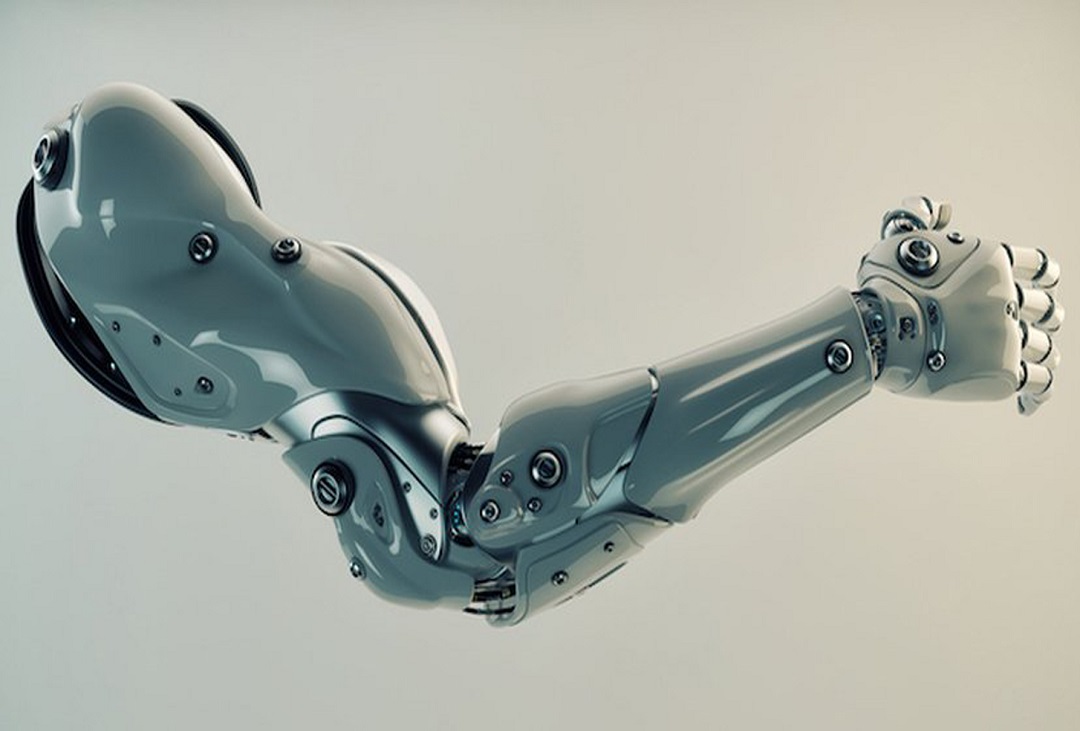Week 10 - Everything I Needed to Know About Prostheses

I've always wondered that if one day we are able to build robotic prosthetics that look just like the real deal but come with all the perks of machinery (strength, durability, modification, etc.), would I willing amputate my arm and replace it with something artificial.
Most people probably haven't even thought about this, but it's something that I've been wondering ever since I saw I, Robot in 2004 and saw Will Smith's robotic arm (I would mention Star Wars here too because of Luke's hand, but I can't remember which one I saw first). I thought how awesome it would be to have something like that and hoped that one day it would become a reality.
If you're reading this and you actually have lost a limb and are thinking I'm crazy for even considering removing my own arm for something artificial and that I don't understand what life is like without a part of your body, then yeah, your right. I am crazy and I don't understand. Either way, I want to dedicate this week's post to learning about the history of prosthetics and how we are moving towards a future where bionic prosthetics could make losing a limb less of a debilitating life event.
As with most topics, before we dive into the now and all the flashy tech we have, let's take a brief look at where we came from.
Prosthetics are a way for humans to recover a missing part of their being. I would argue that this has both physical, emotional, and spiritual (in a loose sense of the word) ramifications. As someone who has never lost a limb, I can't speak for what the experience is like, but here is what my assumption is: losing a limb is losing a part of yourself, but not just physically. When you lose something that has been a part of you your entire life (or just never had it to begin with), you probably feel incomplete. In a way, prosthetics are there to fill that void and bring a sense of closure, and renewed functionality, to your life.
Way Back When…
ICYMI: prosthetics aren't a recent invention. The first discovery happened to be a toe that belonged to an Egyptian and probably was made to fulfill a sense of completeness rather than functionality. This toe dates back to 900 B.C. and tells us that at least in the Egyptian culture, the idea of limbs representing wholeness of person was important rather than some functionality (since the first prosthetic found wasn't something like an arm or leg that aided in functionality).
Flash forward a few hundred years to 218 B.C. and we arrive in ancient Rome in the war camps of Marcus Sergius. General Sergius is a famous case in the prosthetics sector as the first documented user of a prosthetic limb. He used a prosthetic hand to hold a shield in battle, and became a well-known and famous general.
In the blink of an eye, we enter the middle-ages and have yet to make any substantial improvements in the prosthetics sector. Many knights used similar iron prosthetics as General Sergius, hundreds of years ago.
It wasn't until the early 16th Century (think the 1500's) that we made significant progress in the prosthetic and amputation sector. These advancements came from French doctor Ambroise Paré who invented hinged hand prosthetics and locking knee joints.
Random fact: he also revived the practice of podalic version (turning the baby inside the womb in so it comes out feet first).
One Small Leap for a Man, One Giant Leap for Prosthetic Legs
As many of us know, the American Civil War brought an immense loss of life. With so much carnage, the prosthetics industry gained a significant number of customers. From this increase of prosthetic usage came the invention of the hangar limb by a wounded Confederate soldier, James Hangar. This hangar limb advanced the industry through the use of hinged joints at both the knee and ankle joints.
The next leap wasn't until 1946 when researchers at UC Berkeley developed a sock for the amputated stubs that aid in prosthetic attachment.
Then, in the 70's, inventor Ysidro Martinez changed the focus of lower limb prosthetics from trying to imitate the motion of normal limbs to focusing on improving gait and reducing friction.
Prosthetics: Functional and Aesthetic
Today, we are moving towards an industry that can personalize, print, and modify limbs for each person. With improved materials, like carbon fiber, and new production styles, people who have lost a limb can now move towards making artificial limbs a part of themselves.
To be clear, I am not saying that everything will magically turn back to normal, but until we find a way to grow back limbs like lizards, this is the next best thing.
Biomechatronics. A fancy word that sounds all sciency and stuff and includes a who slew of disciplines, like biology, mechanics, electronics, and controls. According to the University of Twente, "it focuses on the research and design of assistive, therapeutic and diagnostic devices to compensate (partially) for the loss of human physiological functions or to enhance these functions." Basically, we're building cyborgs.
Biomechatronic scientists are working to blend man and machine (because that always goes well in the movies) in a way that the devices they make can interact with the natural movements and signals given by the human body.
For example, let's outline how your body knows how to walk in the simplest way possible:
-
Your brain sends electrical signals to the muscles in your leg and foot. These muscles know to contract and lift your leg.
-
The nerves in your feet get a feel for the material beneath it and adjust the pressure needed when pushing off and landing. Think about it this way, you walk differently on sand than you do on concrete.
-
The nerves in your leg muscles know how far away the floor is, allowing you to look somewhere else when walking. Most people don't need to look at the ground when they walk unless they're like me and just hate making eye contact with people.
-
After you raise your foot, you keep sending signals from your brain the specify how far to move forward and how strong to bring the foot down.
This system of motion involves three components: "sensors (nerve cells, muscle spindles), actuators (muscles) and a controller (brain/spinal cord)." This article takes a deep dive into how these components work in tandem and the current state of biomechatronics. As I am quickly getting overwhelmed with the amount of reading I need to do, I will not dig into this article for this post.
As the classical cliche saying goes, you don't know what you have until you lose it. Your body is a complex system of biological signals, motor functions, and chemical interplay. Your hands can perform tasks from performing complex surgeries to smashing concrete with a sledgehammer. They can withstand substantial amounts of force and are pretty durable. The same goes for your legs. You can see this by just watching the Olympics or something like the Crossfit Games.
But when you lose something, regardless of whether it's just a finger or your entire arm, you lose a level of functionality. Hence our need for prosthetics.
While we have yet to reach the day where an artificial limb works and feels just like the real thing, we are making strides that are moving in that direction.
Like the above article, I won't be summarizing the seven pages of content that I read due to time constraints. I will say though that the content for the history section looks pretty similar to this articles history section. Coincidence? Possibly. Or, they're just doing what I'm doing.
Two people have become some of the first to have mind-controlled bionic prosthetics. This became possible through various technologies, most notably, implanted myoelectric sensors (IMES) that were placed in muscle tissue near the amputation site. These sensors are able to receive signals from the brain and translate them for the bionic limb into actual motions.
These signals are sent subconsciously, continuously, and in real-time, meaning we have taken another step in making prosthetics that are imitating the real thing. The goal? To one day fully integrate bionic limbs with their users.
How it Works
These smart limbs are able to automatically adjust to a user's walking style and terrain, though a normal bionic prosthetic still requires intentional thought to work. With these mind-controlled prosthetics, however, subconscious and natural movement becomes possible when the electrical signals from the brain are received by the IMES and trigger muscle movement.
Theoretically, amputees no longer need to think about their muscle movement and can do a whole range of actions using their subconscious reflexes.
Too Long; Didn't Read
The history of prosthetics goes back thousands of years, back to ancient Egypt. The first prosthetic discovered was a toe for an Egyptian noblewoman, believed to bring back some sense of wholeness to their being.
Various innovations in the prosthetic field are few and far between, at least until recently. The major advances being:
-
The use of a metal hand by Roman General Marcus Sergius (~200's B.C.)
-
The creation of hinged joints by French doctor Ambroise Paré (1500's)
-
The invention of the hangar limb by wounded Confederate soldier James Hangar (mid-1800's)
-
Researchers at UC Berkeley developed a sock-like covering for stubs (1946)
-
Two bionic arms are attached to Les Baugh in 2014
While these innovations in the prosthetics field have become more common as technology advances, one event tends to surround these innovations: war.
When many soldiers came back from war missing a limb or two, demand for prosthetics spiked. Therefore, so did the brainpower behind making prosthetics more durable, efficient and socially acceptable.
Until recently, most prosthetics were made of wood or metal that had very limited functionality, if at all. But with the onset of computers, motors, and the rewiring of electrical signals sent throughout the body, humans can do build limbs that just require thought to move.
Obviously, these bionic limbs are still in their early stages of life, but at least can see how the loss of a limb can be compensated with something with decent functionality (assuming you have the financial resources).
Notable Mentions:
